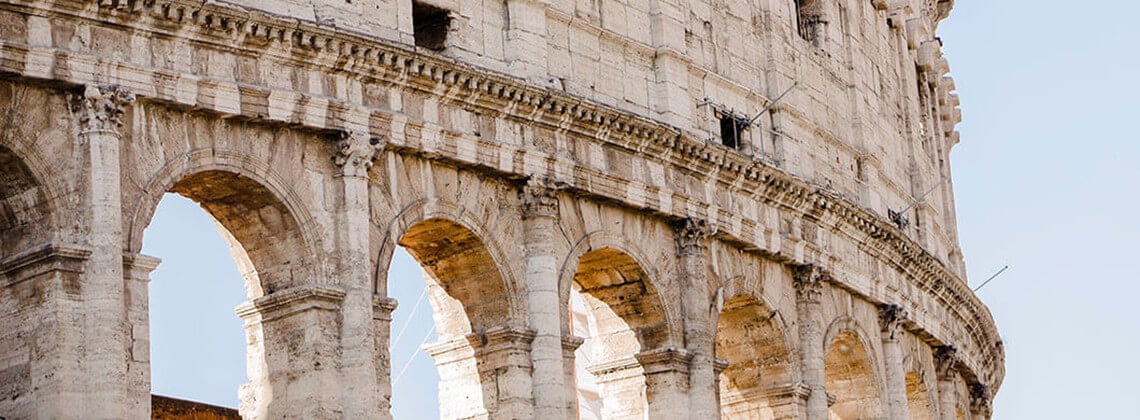Learning how concrete has shaped human history takes us back millions of years ago. Evidence of natural concrete from limestone and oil shale occurred in Israel with spontaneous combustion. The Romans, however, had the process of concrete mastered. There is written evidence that concrete has been around since at least the first century. A large amount of concrete structures still endure to today in the throughout the former Roman empire. It was used in tiles, flooring, and grand structures.
Concrete: Shaping Human History
We know that concrete has to have a certain composition of aggregate ingredients and moisture level. It is evident that without our modern-day materials testing equipment, they were successful at getting the concrete to remain strong despite weathering and erosion. In fact, the great Roman aqueducts were built out of concrete and still stand more than two thousand years later. The techniques of Roman concrete construction were lost with the empire.
In modern construction, concrete is heavily utilized. In the past four hundred years, we have revived the art of concrete, incorporating mortar and stucco. We have also introduced reinforcement elements to strengthen concrete. While some processes approach the endurance of Roman concrete, it remains uncertain whether they will withstand similar conditions over time. In addition, we don’t require such enduring concrete construction with the way our society grows and changes. We do, however, test the cement and concrete to ensure that it will stand the test of time we are looking for which is a hundred years, rather than thousands.
Click here for a full view of a Historical Timeline of How Concrete Has Shaped Human History and learn more about how concrete has shaped human history today.
Concrete, an amalgamation of aggregates bonded with cement, stands as one of humanity’s oldest and most versatile building materials. Spanning a history of several millennia, its evolution has been intrinsically linked to the progress of civilization. In this 2000-word overview, we explore how concrete has shaped human history, delving into its ancient origins, technological advancements, and its profound impact on modern society.
Ancient Origins and Evolution of How Concrete Has Shaped Human History
Early Beginnings of How Concrete Has Shaped Human History
The story of concrete dates back to prehistoric times, with the earliest known form of a concrete-like material used by Nabataean traders in Syria and Jordan around 6500 BC. These early builders used lime and gypsum to create rudimentary binders, setting the stage for future advancements.
Roman Era: The Concrete Revolution of How Concrete Has Shaped Human History
Concrete’s first significant leap in technology came with the Romans, who developed a revolutionary form of concrete around 300 BC. This early concrete, made from a mixture of volcanic ash, lime, and seawater, exhibited hydraulic properties, allowing it to set underwater. Roman engineers utilized this material to construct enduring structures, aqueducts, and monuments. Iconic structures such as the Pantheon and the Colosseum in Rome bear witness to the durability and strength of Roman concrete.
Keep Reading: Concrete Mixer Trailer Guide [2024]: Get Ready For Your Project.
Middle Ages to the Renaissance: A Dormant Phase of How Concrete Has Shaped Human History
After the fall of the Roman Empire, the knowledge of concrete largely faded, marking a regression in construction techniques during the Dark Ages. As the art of concrete was lost in Europe, construction techniques reverted to older forms.
Renaissance Revival of How Concrete Has Shaped Human History
The Renaissance period saw a rekindling of interest in ancient architectural knowledge, including Roman concrete techniques. However, these skills were not fully revived, and the use of concrete remained limited during this era.
The Industrial Revolution: A New Dawn for Concrete
Emergence of Modern Cement
The development of Portland cement in the 19th century by Joseph Aspdin, an English stone mason, marked a significant turning point. This modern cement, created by burning limestone and clay, provided a stronger and more reliable binder, which became the standard for concrete production.
Widespread Use in Construction
With the advent of Portland cement, concrete’s use in construction projects became widespread. It enabled the creation of robust infrastructures such as bridges, tunnels, and buildings, laying the foundation for modern urban development.
More Read: Finding the Workability of Concrete with the Slump Test.
20th Century: The Age of Concrete
Reinforced Concrete
The introduction of reinforced concrete, which combined the tensile strength of steel with the compressive strength of concrete, revolutionized building construction. It allowed for the creation of skyscrapers, extensive road networks, and massive public works projects, altering the architectural landscape of cities worldwide.
Concrete in World War II
During World War II, concrete played a crucial role in military infrastructure. It was used to construct bunkers, airfields, and other military installations, owing to its durability and ease of use.
Post-War Era and Modern Developments
Expansion of Urban Infrastructure
In the post-war era, concrete became the primary material in the global expansion of urban infrastructure. Its versatility facilitated the construction of highways, dams, and urban housing, crucial for accommodating the rapid growth of cities.
Architectural Innovations
Concrete significantly influenced architectural styles, particularly in the mid-20th century with the Brutalist movement. Architects leveraged concrete’s versatility to create structures characterized by minimalist forms and raw, exposed surfaces.
Environmental Impact and Sustainability Challenges
Carbon Footprint
The production of Portland cement, a key component of concrete, is a significant source of CO2 emissions, contributing to global climate change. This has led to growing concerns about the sustainability of concrete as a building material.
Efforts Towards Eco-Friendly Concrete
Recent decades have seen efforts to reduce the environmental impact of concrete through the development of greener alternatives. These include the use of recycled materials, alternative cement, and additives that reduce the carbon footprint of concrete production.
Technological Advancements and Future Trends
Innovations in Concrete Technology
Advancements in concrete technology have led to the development of new forms, such as self-healing concrete, which uses bacteria to produce limestone and seal cracks. Ultra-high-performance concrete offers greater strength and durability, pushing the boundaries of what can be achieved with this material.
Future Prospects
The future of concrete technology is likely to focus on sustainability, with research into reducing its environmental impact while maintaining its strength and versatility. Innovations in smart concrete, capable of sensing structural changes, are also on the horizon.
Global Influence and Cultural Significance of How Concrete Has Shaped Human History
Concrete in Developing Countries
In developing countries, concrete plays a critical role in infrastructure development, offering an affordable and durable solution for housing and public buildings.
Symbolism and Cultural Impact
Concrete has also had a significant cultural impact. It has been both celebrated as a symbol of modernity and progress and critiqued as representative of the cold, impersonal aspects of urbanization.
Conclusion
The story of concrete is a testament to how concrete has shaped human history and ingenuity and the quest for durable and versatile building materials. From its ancient origins to its modern applications, concrete has not only shaped our physical world but also left an indelible mark on human history. As we move into the future, concrete evolves, entwining with our pursuit of sustainable development and architectural innovation. Concrete, a material that withstands time, cements its legacy in human progress, reflecting our ongoing efforts to build and enhance our living environment.

